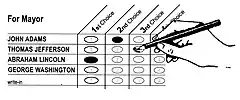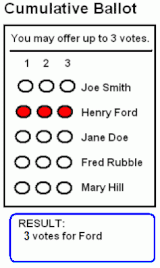Bullet voting,[1] also known as single-shot voting[2] and plump voting,[3] is a voting tactic, usually in multiple-winner elections, where a voter is entitled to vote for more than one candidate, but instead votes for only one candidate.
A voter might do this because it is easier than evaluating all the candidates or as a form of tactical voting. Voters can use this tactic to maximize the chance that their favorite candidate will be elected while increasing the risk that other favored candidates will lose. A group of voters using this tactic consistently has a better chance of one favorite candidate being elected.[4][5]
Election systems that satisfy the later-no-harm criterion discourage any value in bullet voting. These systems either do not ask for lower preferences (like plurality) or promise to ignore lower preferences unless all higher preferences are eliminated.
Some elections have tried to disallow bullet voting and require the casting of multiple votes because it can empower minority voters. Minority groups can defeat this requirement if they are allowed to run as many candidates as seats are being elected.[6][7]
Single winner elections
Plurality voting only allows a single vote, so bullet voting is effectively mandatory. Voting for more than one candidate is called an overvote and will invalidate the ballot.
In contrast, approval voting allows voters to support as many candidates as they like, and bullet voting can be a strategy of a minority, just as in multiple-winner elections (see below). Such voting would be for their sincere favorite, so it would not result in the same pathologies seen in plurality voting, where voters are encouraged to bullet vote for a candidate who is not their favorite. Bucklin voting[8] and Borda voting used ranked ballots, and both allow the possibility that a second choice could help defeat the first choice, so bullet voting might be used to prevent this.
Instant-runoff voting and contingent vote allow full preferences to be expressed and lower preferences have no effect unless the higher ones have all been eliminated. Therefore, bullet voting has no tactical advantage in these cases: on the contrary, it can lead to a loss of influence if no ranking is expressed among the final two candidates.
| Bullet vote | Preference vote | |
|---|---|---|
 |
 |
 |
| Marked a single preference | Marked all preferences the same (Lower rankings for the same candidate are ignored) |
In process marking third preference |
Multiple winner elections
| System | Votes |
|---|---|
| Approval voting Range voting Borda voting | Point scores |
| Plurality-at-large voting | N |
| Limited voting | N-1 N-2 ... |
| Single nontransferable vote (Whole vote) | 1 |
| Instant runoff voting (Whole vote) | 1 |
| Cumulative voting (Explicit divided vote) | 1 |
| Single transferable vote (Implicit divided vote) | 1 |
Multiple votes are often allowed in elections with more than one winner. Bullet voting can help a first choice be elected, depending on the system:
- Multiple non-transferable vote methods
- Approval voting used in a multi-winner election works the same way as Plurality-at-large but allows more votes than winners. This results in a body that is less representative than a body elected under a proportional voting method but would still have the same ideological center as the population.[9] 100% bullet voting under Approval Voting in a multi-winner election is unlikely, as voters are incentivized to vote for acceptable moderates in addition to their favorite candidates to avoid being locked out of the election entirely.[10]
- Range voting is a generalization of Approval voting where voters can give gradations of support for each candidate. Here bullet voting refers to providing 100% support for one candidate and 0% for all other candidates, just like Approval bullet voting.
- Borda voting assign multiple votes based on ranked ballots, like three votes for the first, two for the second, and one for the third choice. This encourages minority voters to bullet vote (not using all the rankings). If voters are required to rank all the candidates, it further encourages voters to (insincerely) bury strongest rivals at the lowest rankings.
- Plurality-at-large voting (Bloc-voting) allows up to N votes for elections with N winner elections. In this system, a voter who prefers a single candidate and is concerned his candidate will lose has a strong incentive to bullet vote to avoid a second choice helping to eliminate the first choice.[11] A united majority of voters in plurality-at-large can control all the winners despite any strategic bullet voting by a united minority.
- Limited voting goes the opposite way as Approval, allowing fewer votes than winners. This reduces the ability of a united majority of voters to pick all the winners and gives more influence to minority voters who would bullet vote anyway.[12]

- One Vote Systems
- A single nontransferable vote limits everyone to one vote, effectively making bullet voting mandatory, minimizing the power of a majority of voters to pick all the winners, and can work well if there are only a few more candidates as winners.[13]
- Cumulative voting allows up to N votes for N winner elections which can be distributed between multiple candidates or all given to one candidate. Effectively, this is one vote which can be fractionally divided among more than one candidate. This removes any penalty to bullet voters, who support a single candidate, and it enables the possibility of a united minority to elect at least one winner despite a united majority voting for all other candidates.
- Instant runoff voting and Single transferable vote take away the incentive for bullet voting (leaving candidates unranked) entirely since lower rankings are only used if all higher choices are elected or eliminated. STV goes one step further than IRV, computing a threshold for electability, like 20% for four candidates, and when a candidate is elected, supporters get a surplus fraction of their vote transferred to their next choice. This increases the value of giving full preferences.
See also
References
- ↑ Bullet Voting Explained
- ↑ Merits Of Single-Shot Voting Questioned
- ↑ EDITORIAL: To plump, or not to plump your vote
- ↑ "Does "Bullet Voting" Really Work? - Philadelphia Magazine". Philadelphia Magazine. 2015-10-27. Retrieved 2017-07-12.
- ↑ "Ocean City Maryland News | OC MD Newspapers | Maryland Coast Dispatch » Merits Of Single-Shot Voting Questioned". mdcoastdispatch.com. 22 October 2008. Retrieved 2017-07-13.
Single-shot voting is essentially a tactic used by voters ... choosing only one candidate or a lesser amount of candidates than open seats.
- ↑ "Drawing the Line". Southern Poverty Law Center. Archived from the original on 2017-02-21. Retrieved 2017-07-13.
4. Anti-single-shot provisions: These provisions compel voters to cast a vote for every open seat, even if voters do not want to support more than one candidate. A voter who casts a vote for less than the entire number of seats open (a "full slate") will not have their ballot counted. Requiring minority voters to vote for a full slate dilutes their voting strength by preventing them from concentrating their support behind one candidate.
- ↑ Decision 1997: Constitutional Change in New York By Henrik N. Dullea, 1997
- ↑ Democracy in Divided Societies: Electoral Engineering for Conflict Management, Benjamin Reiley, 2001 ISBN 0521797306 p.145 ("But the Bucklin system was found to be defective, as it allowed a voter's second choice vote to help defeat a voter's first choice candidate. Under these circumstances, most voters refrained from giving second choices, and the intent of discovering which candidate was favored by the majority was thwarted.)"
- ↑ "Approval Voting is Better Than Plurality Voting, Even in Multi-Winner Races". 7 June 2020.
- ↑ The Troubling Record of Approval Voting at Dartmouth
- ↑ Amy (2000) p.60 ('At-large voting can discourage voters from supporting all the candidates they want to see on the council, a practice called bullet voting... This is a political predicament racial minorities find themselves. They must give up all of their other votes to have any hope of electing their first choice.)
- ↑ Amy (2000) p. 130. (As with at-large voting, if you choose all your votes in limited voting, there is a chance this strategy can be self-defeating... you vote may help other candidates defeat your favorite one.)
- ↑ "Black candidate for Euclid school board to test new voting system". Archived from the original on 2011-06-07. Retrieved 2011-06-07.
Further reading
- Behind the Ballot Box: A Citizen's guide to voting systems, Douglas J Amy, 2000. ISBN 0-275-96585-6
- Mathematics and Democracy: Recent advances in Voting Systems and Collective choice, Bruno Simeone and Friedrich Pukelsheim Editors, 2006 ISBN 978-3-540-35603-5